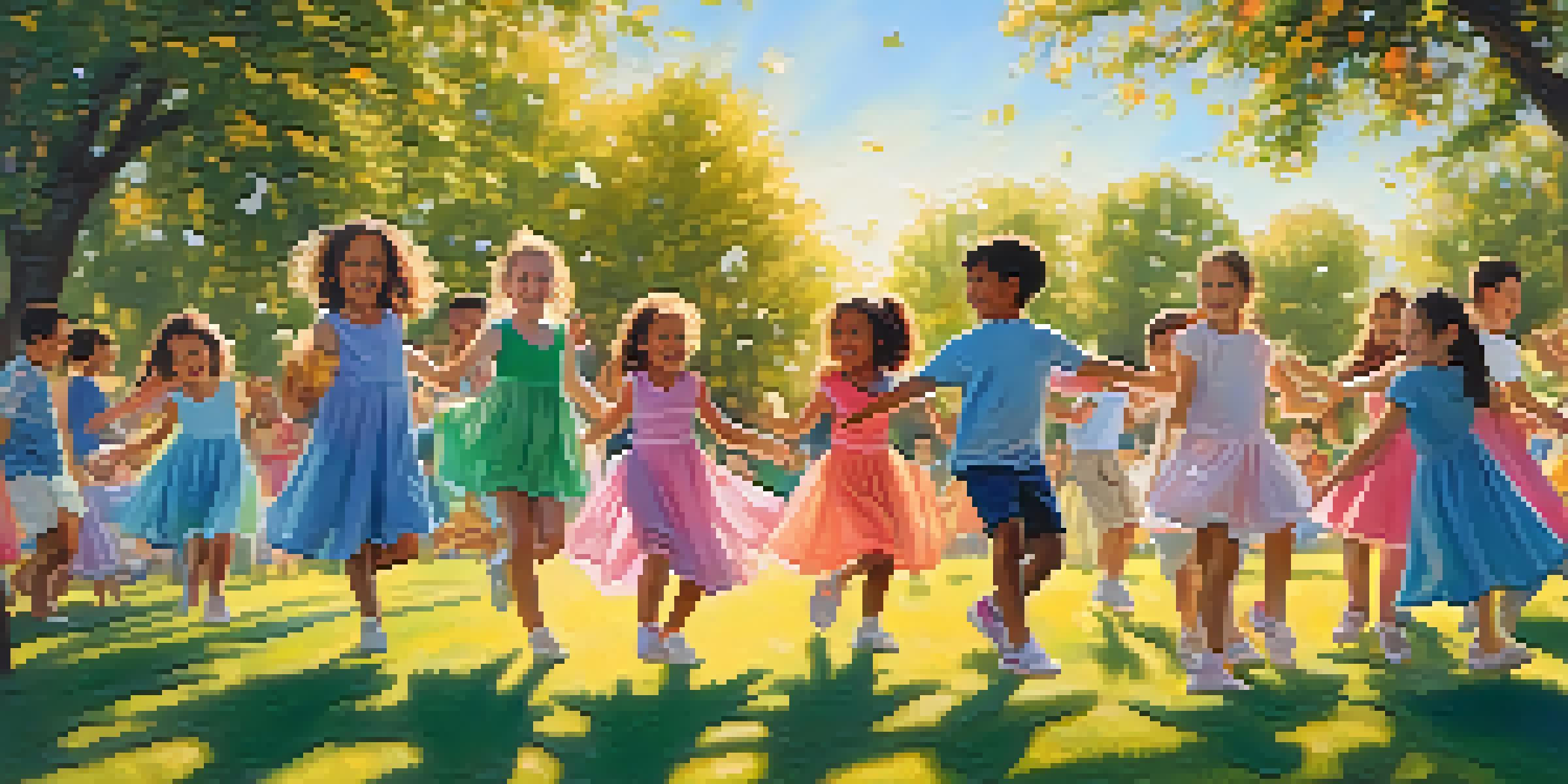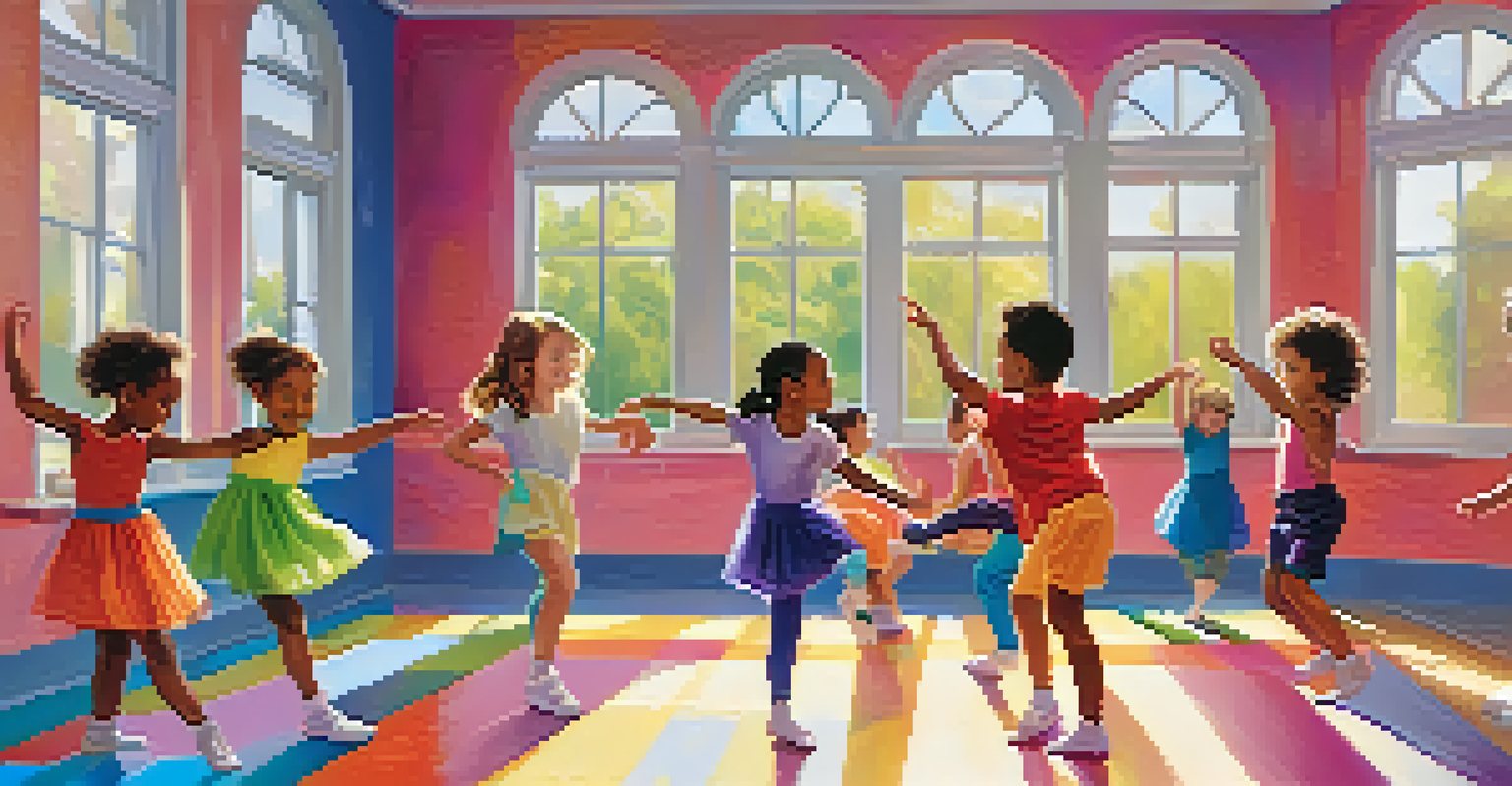Incorporating Dance into Playtime for Developmental Benefits

Understanding the Connection Between Dance and Development
Dance is not just a fun activity; it's a powerful tool for child development. When children dance, they engage their bodies and minds, fostering a holistic growth experience. This connection between movement and mental processing enhances skills like coordination, balance, and rhythm, which are crucial during early development.
Dance is the hidden language of the soul.
Moreover, dance encourages children to express themselves creatively. They learn to convey emotions and stories through movement, which enhances their communication skills. Just like learning a language, the more they practice, the more fluent they become in expressing their feelings and ideas.
Additionally, incorporating dance into playtime can significantly boost confidence. As children master new dance steps or create their own routines, they gain a sense of achievement. This newfound confidence can spill over into other areas of their lives, from academics to social interactions.
Benefits of Dance for Physical Development
Engaging in dance helps children develop essential physical skills. From strength and flexibility to coordination and endurance, dance provides a comprehensive workout that promotes overall fitness. Think of it as a fun way to encourage exercise without the feeling of a formal workout.

Through dance, children also improve their motor skills. Simple movements like jumping, spinning, or sliding help refine their gross motor skills, while intricate footwork enhances fine motor skills. This is particularly important as these abilities are foundational for later activities, such as sports or even writing.
Dance Boosts Child Development
Engaging in dance supports physical, cognitive, and emotional growth in children.
Moreover, dance introduces rhythm and timing, which are vital for various physical activities. As children learn to move in sync with music, they're not only having fun but also developing their sense of timing, which can be beneficial in sports and other physical endeavors.
Cognitive Benefits of Dance in Playtime
Dance also stimulates cognitive development in children. Learning and remembering dance routines requires concentration and memory, which can enhance their overall cognitive abilities. This mental workout can lead to improved focus, analytical thinking, and problem-solving skills.
Dancing is like dreaming with your feet!
Furthermore, dance encourages pattern recognition and spatial awareness. As kids learn dance moves, they begin to understand how their bodies relate to space and movement. This awareness is crucial for academic skills, especially in subjects like math and science, where spatial reasoning plays a significant role.
Additionally, dancing often involves a social component, whether it's in a group class or just with friends. This social interaction boosts critical thinking as children learn to read social cues and adapt their movements based on the dynamics of the group.
Emotional Development Through Dance
Incorporating dance into playtime is a fantastic way to support emotional growth. Dance allows children to express their feelings in a safe and constructive manner. When they move to music, they can process emotions like joy, sadness, or excitement, which can be particularly beneficial during challenging times.
Moreover, dance fosters resilience and adaptability. As children learn new routines and face challenges in mastering movements, they develop perseverance. This ability to keep trying despite setbacks is a valuable life skill that will serve them well beyond childhood.
Dance Enhances Social Skills
Participating in dance promotes cooperation, communication, and a sense of belonging among peers.
Additionally, participating in dance can build empathy in children. When they dance with others, they learn to appreciate different perspectives and experiences, helping them to connect on a deeper level with their peers.
Social Skills Development Through Dance
Dance provides a rich environment for developing social skills. Whether in a group class or at a family gathering, dancing together encourages cooperation and teamwork. Children learn to take turns, share space, and coordinate their movements with others, which are all essential social skills.
Furthermore, dance often requires communication, both verbal and non-verbal. Kids learn to express themselves through body language and gestures, enhancing their overall communication abilities. This skill is especially important as they navigate friendships and social settings in school.
Additionally, dance can create a sense of belonging. When children participate in group dances or performances, they feel part of a community. This sense of connection can significantly boost their self-esteem and social confidence.
Creative Expression and Imagination in Dance
Dance is a unique form of creative expression that allows children to explore their imagination. When they create their own dance moves or routines, they are engaging in a form of storytelling that enhances their creativity. This open-ended nature of dance encourages kids to think outside the box and explore new ideas.
Moreover, dancing to different styles or genres of music can broaden their cultural awareness. As children experience various dance forms, they gain insights into different cultures and traditions, fostering an appreciation for diversity. This exposure can enrich their understanding of the world around them.
Creativity Through Dance
Dance encourages imaginative expression and cultural awareness, enriching children's understanding of the world.
Additionally, the improvisational aspect of dance invites spontaneity. When children are encouraged to freestyle, they learn to trust their instincts and embrace their unique movements. This freedom can lead to innovative thinking and problem-solving skills in other areas of their lives.
Practical Ways to Incorporate Dance into Playtime
Incorporating dance into playtime doesn't have to be complicated. Start by playing a variety of music genres and encouraging children to move freely to the beat. This spontaneous dance party allows them to express themselves without any rules or restrictions, making it a fun and engaging experience.
You can also introduce structured dance activities, such as learning simple dance routines together. Online dance tutorials or local dance classes can be great resources. These activities not only teach them new skills but also provide opportunities for bonding and shared experiences.

Furthermore, consider integrating dance into everyday routines. For example, create a fun dance challenge during chores or incorporate dance breaks during homework sessions. This keeps playtime lively and reinforces the idea that dance can be a joyful part of daily life.